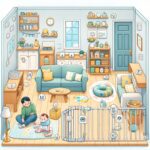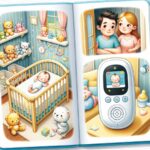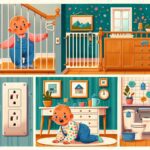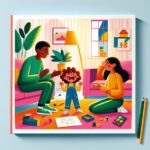Ensuring the safety of your home for your little explorer is paramount, and implementing tips for baby-proofing your home effectively is the first step towards creating a secure environment. As babies grow, their curiosity does too, making it essential to anticipate potential hazards and take preventive measures. This guide delves deep into practical strategies to safeguard your home, ensuring peace of mind for you and a safe exploration space for your baby.
Tips for Baby-Proofing Your Home Effectively
Baby-proofing your home involves more than just securing cabinets and covering sharp corners; it’s about creating an environment where your baby can explore safely. Start by assessing your home from a baby’s perspective, identifying potential hazards that might not be immediately obvious to adults. Electrical outlets, loose cords, and small objects that can be swallowed should be on your radar.
Securing furniture to the walls is crucial, as dressers and bookshelves can pose tipping hazards. For more in-depth information on baby-proofing against specific risks, this article offers comprehensive insights. Remember, the goal is to mitigate risks without stifling your baby’s natural curiosity and desire to explore.
Identifying Hidden Dangers in Your Home
Some hazards might not be immediately apparent, making it essential to conduct a thorough walk-through of your home. Pay special attention to items that babies can pull down onto themselves, such as tablecloths or cords. Plants, too, can be toxic if ingested; ensure all houseplants are safe for babies.
Additionally, water safety is paramount. Even a small amount of water can be a drowning risk for infants. Always keep bathroom doors closed, and consider toilet locks to prevent access. For more on water safety, read this guide.
Enhancing Safety with Baby Monitors and Other Tools
Baby monitors are invaluable tools for keeping an eye on your little one, even when you’re not in the same room. They provide peace of mind and an extra layer of safety. When choosing a baby monitor, consider features like camera quality, range, and whether it offers secure, encrypted signals. For recommendations, check out this list of the best baby monitors.
Other tools, like cabinet locks and door knob covers, are straightforward yet effective ways to prevent access to dangerous areas. Investing in corner protectors can also significantly reduce the risk of injury from sharp furniture edges. Detailed tips on selecting and installing these tools can be found here.
Remember, baby-proofing is an ongoing process that evolves with your child’s development. Regularly reassess your home for potential hazards as your baby grows and explores new areas. For more tips on creating a safe environment for your baby, explore our comprehensive guide on baby-proofing your home effectively. With the right precautions, you can create a home where your baby can safely grow, learn, and play.













